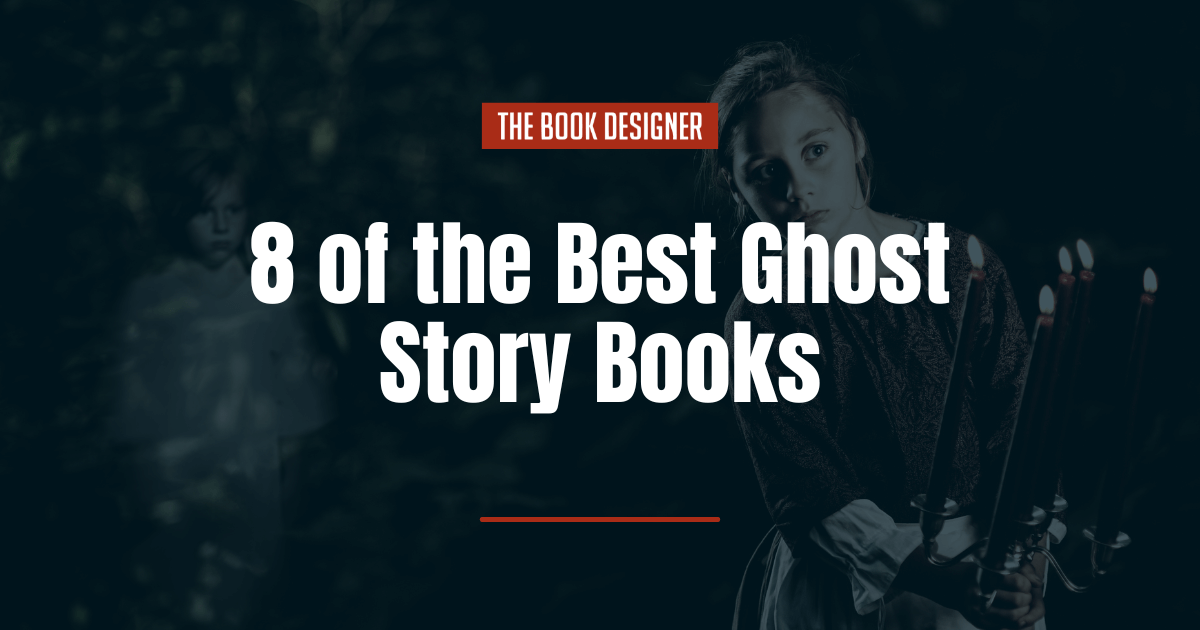Halloween is here, so it’s time to settle in with a good old fashioned ghost story. If you’re new to the genre or if you have no idea where to even begin with your Halloween festivities, no worries! I’ve got some recommendations for you today.
We’re here to talk about ghost stories: what counts as a ghost story, what differentiates them from horror, what are their key characteristics, and what are the best ghost stories out there?
We’ve got a lot of ground to cover, so let’s get started with 8 of the best ghost story books.
What counts as a ghost story?
Before we talk about some of the ghost stories you should check out, let’s discuss the genre as a whole. What do I mean when I say ‘ghost stories,’ and what counts as a ghost story?
Ghost stories have to have a ghost—that’s a given. The ghost needs to be a prominent feature in the story. Ideally, the ghost is either the main character or the central conflict. Without the ghost, the story doesn’t exist. It’s about ghosts.
Ghost stories don’t have to be about the ghost’s background or the ghost’s life as a living person. That might not come up at all, or it might be just set-dressing. The most important thing is that the ghost is essential to the plot—what’s important is how it interacts with the characters. What does it make the characters learn about themselves? What does it force them to do?
If the story is about the ghost, then of course we need to know why the ghost is haunting our characters and what the ghost was like as a living person. These just aren’t the criteria for what constitutes a ghost story.
Ghost stories vs. horror stories
A ghost story, as I’ve said, is a story about a ghost—either the ghost is central to the plot by way of being the conflict or by way of being the main character. But what about being scary?
In my humble opinion, a good ghost story need not be scary. It’s easy to make ghosts scary, and I think you’re doing the reader a disservice if you don’t at least lean into the scariness a little bit or acknowledge it in some way, but it’s not a requirement.
Horror stories and ghost stories are not interchangeable terms. A horror story is a story that’s meant to scare the reader—the content is supposed to make them feel uncomfortable, icky, frightened, repulsed, disgusted, etc. A ghost story, on the other hand, just needs to have a ghost and be interesting. Spooky atmosphere is a bonus, but that’s just my personal preference.
Key characteristics of ghost stories
What are some characteristics which make ghost stories great? So glad you asked.
1. An engaging plot
I love a ghost story where the ghost is an unpleasant surprise and unwelcome part of the conflict. The characters are trying to do something unrelated, and now they’ve got a ghost to worry about. Nothing against Ghost Adventures or anything of that sort—I just like a circumstantial ghost.
Ghosts also work best when they’re involved in some kind of mystery. They immediately confront the reader with themes of death, life after death, sometimes legacy, sometimes immortality, sometimes past trauma or shadows in a person’s life. The idea of a ghost is a thing from another life which is still here. It’s inherently obtrusive and inherently disturbing.
These themes are all rich with storytelling potential, and they make for incredibly engaging plots. Characters can be dealing with ghosts literally, and with ghosts of their past in a figurative sense (I’m thinking about Haunting of Hill House (TV) here). Ghosts could be a dying old man’s way of reckoning with the legacy he leaves after his passing, or they could be someone’s way of exacting revenge on the person who wronged them.
Revenge, death, mystery, past lives—there’s lots to work with here.
2. Characters having their own relationship to the ghost
Ghosts can be nameless, relatively faceless spirits who mostly jumpscare the reader and dip. These ghosts pose more of a physical threat than anything else, and this is not what I’m interested in.
I love when characters have relationships with the ghosts. This is usually thematically tied to their relationship with fear, and it deals a lot with what they’re afraid of, why, and how they’re going to overcome that fear. In kid’s shows or campy short stories it’s fine to have a ghost that just shows up and says ‘boo,’ but if the ghost is sticking around, I want characters to develop alongside that ghost.
3. An unsettling atmosphere
Like I said, ghost stories don’t have to be scary. Plenty aren’t! But I do think ghost stories should lean into a creepy atmosphere.
Have you seen the Goosebumps TV show? If you haven’t, you should definitely check it out—it’s a timeless classic and a riot. But that show is a perfect example of what I’m talking about here. The episodes lean into spooky Hallow’s Eves, foggy forests, crowded basements, dark rooms, and so on, because the showrunners understand how fun that setting can be. It doesn’t make the content particularly frightening, but it does pay homage to the spirit of the Halloween season.
4. A little character development for the ghost
This one is super optional—a lot of ghost stories have the ghost mostly feature as a foe to be vanquished, put to rest, or otherwise excised. As I mentioned earlier, ghosts are inherently out of place (dead amongst the living), so the easiest way to solve the conflict is to identify the thing which does not belong and get it out of there.
But the more interesting way, I think, is to get to know the ghost. Must we adhere to a living/dead binary? Perhaps we make peace with the ghost. Perhaps we even befriend her. We might even just come to a more complex understanding of the ghost.
Again to use Haunting of Hill House (TV) as an example—when you learn what’s going on with the Bent-Neck Lady, she doesn’t scare you nearly as much when you see her. She mostly seriously, seriously bums you out. That’s a more interesting and dynamic experience, I think, and it leaves much more room to really explore themes like death and illness.
Best ghost story books
So, all that said, let’s talk about some great ghost story books! I’ve included links to each book along with the juicy bits of each description to give you an idea of what you’re getting into.
Haunting of Hill House by Shirley Jackson
“First published in 1959, Shirley Jackson’s The Haunting of Hill House has been hailed as a perfect work of unnerving terror. It is the story of four seekers who arrive at a notoriously unfriendly pile called Hill House: Dr. Montague, an occult scholar looking for solid evidence of a “haunting”; Theodora, his lighthearted assistant; Eleanor, a friendless, fragile young woman well acquainted with poltergeists; and Luke, the future heir of Hill House. At first, their stay seems destined to be merely a spooky encounter with inexplicable phenomena. But Hill House is gathering its powers—and soon it will choose one of them to make its own.”
Wuthering Heights by Emily Bronte
“Wuthering Heights is the name of the farmhouse where the story unfolds. The book’s core theme is the destructive effect of jealousy and vengefulness both on the jealous or vengeful individuals and on their communities.”
The Turn of the Screw by Henry James
“By the comforts of a blazing fireplace on a cold Christmas Eve night, guests at a holiday party share stories of phantoms and ghosts of Christmases past. Yet one guest delivers a tale of sheer fright for which no one listening was prepared. As the story goes, after losing both parents, a young boy and girl move into a large wooded estate to be held under the care of their uncle. Wanting nothing to do with raising the children, the uncle hires a young governess to attend to their care. Yet the governess never could have anticipated the horrors that await her discovery. When it becomes evident that the children have some supernatural connection with a deceased former governess and her lover, the young governess finds herself scrambling to regain control of two children slipping away from her grasp.”
Scary Stories to Tell in the Dark by Alvin Schwartz
“Scary Stories to Tell in the Dark is a timeless collection of chillingly scary tales and legends, in which folklorist Alvin Schwartz offers up some of the most alarming tales of horror, dark revenge, and supernatural events of all time.”
Hell House by Richard Matheson
“Rolf Rudolph Deutsch is going die. But when Deutsch, a wealthy magazine and newspaper publisher, starts thinking seriously about his impending death, he offers to pay a physicist and two mediums, one physical and one mental, $100,000 each to establish the facts of life after death.
Dr. Lionel Barrett, the physicist, accompanied by the mediums, travel to the Belasco House in Maine, which has been abandoned and sealed since 1949 after a decade of drug addiction, alcoholism, and debauchery. For one night, Barrett and his colleagues investigate the Belasco House and learn exactly why the townsfolk refer to it as the Hell House.”
“Beginning with Archer St. John’s 1949 first issue of Casper the Friendly Ghost, this sixtieth anniversary edition continues with Harvey Comics’ premier edition of Casper from 1952. You’ll thrill as timid Casper – defying his fellow ghosts’ dictum that ghosts must scare people – makes friends with a host of cute kids and furry animals in two tales that will touch your heart and tickle your funny bone!”
“What was the worst thing you’ve ever done?
In the sleepy town of Milburn, New York, four old men gather to tell each other stories – some true, some made-up, all of them frightening. A simple pastime to divert themselves from their quiet lives.
But one story is coming back to haunt them and their small town. A tale of something they did long ago. A wicked mistake. A horrifying accident. And they are about to learn that no one can bury the past forever…”
The Legend of Sleepy Hollow by Washington Irving
“Ichabod Crane, a schoolteacher, came to Tarry Town in the glen of Sleepy Hollow to ply his trade in educating young minds. He was a gullible and excitable fellow, often so terrified by locals’ stories of ghosts that he would hurry through the woods on his way home, singing to keep from hysterics. Among these stories was the legend of the Galloping Hessian, the headless horseman of Sleepy Hollow.”




